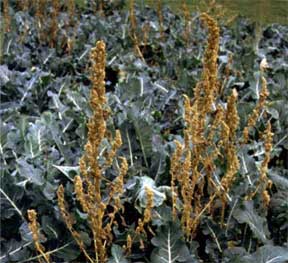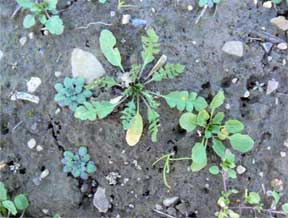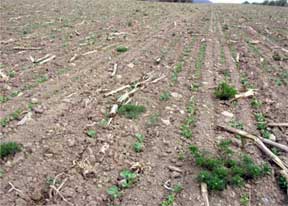Fall weed management tips: Preventing seed production and establishment of winter annuals
Editor’s note: This article is from the archives of the MSU Crop Advisory Team Alerts. Check the label of any pesticide referenced to ensure your use is included.
Fall is an important time to evaluate holes in weed management programs and note the location of problematic weeds in order to help crop rotation and weed management planning for next year. This is also a good time to take steps to minimize the number of weed seeds added to the soil, and to prevent establishment of winter annuals.
Avoiding summer annual seed production
As crops come out of the field, weeds that are left behind often sow seeds of future problems. For summer annual weeds like pigweed and lambsquarters, the short days of late summer stimulate seed production. Even small plants can produce thousands of seeds at this time of year which can last for decades in the soil. Larger plants can produce from a few thousand seeds (e.g. velvetleaf, smartweed, crabgrass) to 300,000 or more (e.g pigweed, lambsquarters) per plant (photo 1). Seeds of many weed species can last for decades in the soil, creating weed management headaches for years to come. To minimize future weed problems it is therefore important to till or disk fields as soon as possible after harvest to prevent seed maturation. Mowing can also be affective in slowing and reducing seed production, but growth and seed production from lateral branches can be problematic. However, once weed seeds are shed on the soil surface, tillage may be counterproductive, since seed burial protects seeds from predation and decay. Weed seeds are a significant food source for many insects and bird species and can have rates of mortality of 75 percent or greater if left on the soil surface during the fall.
Preventing winter annual establishment
Winter annual weed seeds that have been dormant during the summer begin to germinate in the fall following vegetable crop harvest. These species overwinter and can quickly form a mat in the spring that can interfere with field preparation, slow soil warm-up, and compete with crop growth. Some winter annual weeds can also be important hosts of pests of vegetable crops. For example, recent studies suggest that shepherd’s-purse and field pennycress (photo 2) may host insects (e.g. swede-midge) and diseases (e.g. black rot) of mustard family vegetables. In reduced tillage systems, winter annuals can be particularly problematic. For example, spring chisel-plowing and glyphosate applications are ineffective at controlling fall-germinating corn chamomile (daisy), which can be a costly contaminant in crops such as peas the following spring (photo 3).
To reduce problems with winter annual weeds, late fall herbicide applications or tillage are often more effective than spring operations. While it is too late this season, cover crops like oats or mustards established after early harvested vegetables are very effective at preventing winter annual weed establishment. For late-harvested vegetables thickly sown winter cover crops like rye, wheat, or hairy vetch can also help suppress winter annual weeds.

Photo 1. The pigweed shown above
produced over 200,000 seeds.

Photo 2. Thale-cress (middle-left), shepherd’s purse
(middle) and field pennycress (middle right) are
winter annuals in the mustard family that may host
insects and diseases of mustard family vegetables.
Also shown are annual bluegrass and chickweed
(lower right).

Photo 3. Overwintering corn chamomile can be a
contaminant in processing peas.
Dr. Brainard's work is funded in part by MSU's AgBioResearch.



 Print
Print Email
Email


